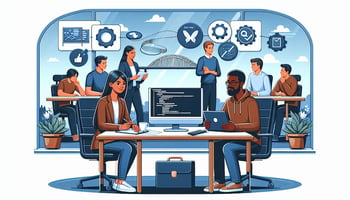Building Bridges: Enhancing Collaboration Between Design and Development Teams

Understanding the Divide Between Design and Development
In many organizations, a divide exists between design and development teams. Designers focus on the user experience, interface, and aesthetics of a product, while developers concentrate on the technical aspects of making it function. This divide can be the result of differing goals, misunderstandings about the others' roles, or simply the nature of specialized work. However, bridging this divide is crucial to produce cohesive and successful products.
Establishing Common Goals
One of the primary ways to enhance collaboration is to establish common goals. Both teams should understand and be committed to the overarching objectives of the project. Facilitating joint sessions where both sides contribute to setting these goals can foster a sense of shared responsibility and focus. Each side should recognize that both the user experience and the technical functionality are key to the project's success.
Creating Integrated Workflows
Integration of workflows involves creating processes that take both design and development considerations into account. This could mean utilizing design tools that are easily translatable to code or adopting agile methodologies that cater to both design and development activities. Cross-functional pairing or swarming during certain phases of a project can also help, where designers and developers collaboratively tackle tasks and solve problems.
Fostering Open Communication
Open communication is the lifeline of effective collaboration. Regular check-ins and updates between teams can keep everyone aligned. Creating a safe environment where team members feel comfortable asking questions and giving feedback is essential. Tools like Slack, Microsoft Teams, or Trello can facilitate this continuous communication, and regular meetings should be set up to ensure everyone is on the same page.
Investing in Cross-disciplinary Training
Cross-disciplinary training can equip team members with a better understanding of their colleagues’ work. Designers could benefit from basic coding workshops while developers might attend design thinking seminars. This type of knowledge sharing can lead to more empathy and patience between teams as they better understand the challenges and limitations faced by their coworkers.
Leveraging Technology to Bridge Gaps
There is a wide array of tools specifically designed to enhance collaboration between designers and developers. These include version control platforms for design files, handoff tools that generate style guides and assets, and prototyping tools that allow both sides to test and iterate quickly. Embracing these technologies can streamline the handoff process, reduce errors, and enable a smoother transition from design to development.
Celebrating Joint Achievements
Finally, acknowledging and celebrating joint achievements can be an effective way of building camaraderie between design and development teams. Recognizing the successful collaboration on a project reinforces the idea that both sides are contributing to a shared vision. Celebrations, whether small or large, can help to break down barriers and build team spirit.
In conclusion, improving collaboration between design and development teams is a critical factor for the success of any project. By understanding each other's challenges, establishing common goals, creating integrated workflows, fostering open communication, investing in cross-training, leveraging technology, and celebrating achievements together, organizations can unlock the full potential of their interdisciplinary teams.




